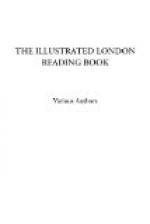The length of the great tube is exactly 470 feet, being 12 feet longer than the clear space between the towers, and the greatest span ever yet attempted. The greatest height of the tube is in the centre—30 feet, and diminishing towards the end to 22 feet. Each tube consists of sides, top and bottom, all formed of long, narrow wrought-iron plates, varying in length from 12 feet downward. These plates are of the same manufacture as those for making boilers, varying in thickness from three-eighths to three-fourths of an inch. Some of them weigh nearly 7 cwt., and are amongst the largest it is possible to roll with any existing machinery. The connexion between top, bottom, and sides is made much more substantial by triangular pieces of thick plate, riveted in across the corners, to enable the tube to resist the cross or twisting strain to which it will be exposed from the heavy and long-continued gales of wind that, sweeping up the Channel, will assail it in its lofty and unprotected position. The rivets, of which there are 2,000,000—each tube containing 327,000—are more than an inch in diameter. They are placed in rows, and were put in the holes red hot, and beaten with heavy hammers. In cooling, they contracted strongly, and drew the plates together so powerfully that it required a force of from 1 to 6 tons to each rivet, to cause the plates to slide over each other. The weight of wrought iron in the great tube is 1600 tons.
Each of these vast bridge tubes was constructed on the shore, then floated to the base of the piers, or bridge towers, and raised to its proper elevation by hydraulic machinery, the largest in the world, and the most powerful ever constructed. For the Britannia Bridge, this consisted of two vast presses, one of which has power equal to that of 30,000 men, and it lifted the largest tube six feet in half an hour.
The Britannia tubes being in two lines, are passages for the up and down trains across the Straits. Each of the tubes has been compared to the Burlington Arcade, in Piccadilly; and the labour of placing this tube upon the piers has been assimilated to that of raising the Arcade upon the summit of the spire of St. James’s Church, if surrounded with water.
Each line of tube is 1513 feet in length; far surpassing in size any piece of wrought-iron work ever before put together; and its weight is 5000 tons, being nearly equal to that of two 120-gun ships, having on board, ready for sea, guns, provisions, and crew. The plate-iron covering of the tubes is not thicker than the hide of an elephant, and scarcely thicker than the bark of an oak-tree; whilst one of the large tubes, if placed on its end in St. Paul’s churchyard, would reach 107 feet higher than the cross of the cathedral.
[Illustration: CONSTRUCTING THE BRITANNIA TUBULAR BRIDGE.]
* * * * *




